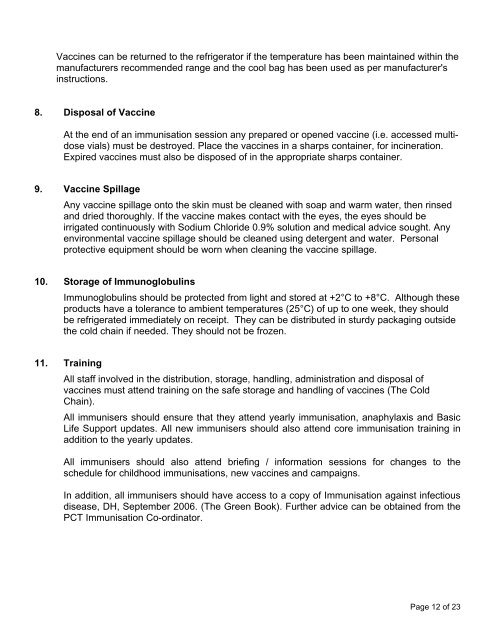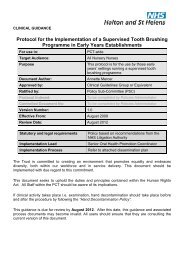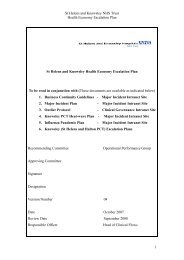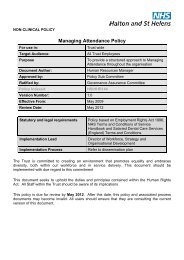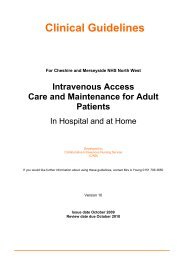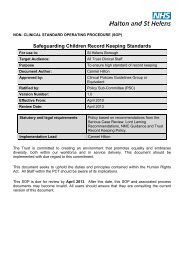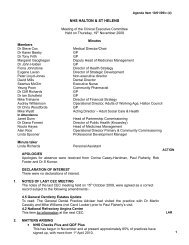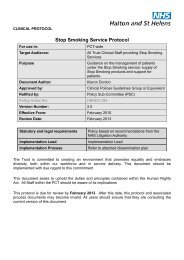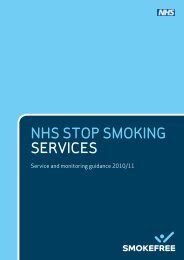(Maintaining the Cold Chain) For - Halton and St Helens PCT
(Maintaining the Cold Chain) For - Halton and St Helens PCT
(Maintaining the Cold Chain) For - Halton and St Helens PCT
Create successful ePaper yourself
Turn your PDF publications into a flip-book with our unique Google optimized e-Paper software.
Vaccines can be returned to <strong>the</strong> refrigerator if <strong>the</strong> temperature has been maintained within <strong>the</strong>manufacturers recommended range <strong>and</strong> <strong>the</strong> cool bag has been used as per manufacturer'sinstructions.8. Disposal of VaccineAt <strong>the</strong> end of an immunisation session any prepared or opened vaccine (i.e. accessed multidosevials) must be destroyed. Place <strong>the</strong> vaccines in a sharps container, for incineration.Expired vaccines must also be disposed of in <strong>the</strong> appropriate sharps container.9. Vaccine SpillageAny vaccine spillage onto <strong>the</strong> skin must be cleaned with soap <strong>and</strong> warm water, <strong>the</strong>n rinsed<strong>and</strong> dried thoroughly. If <strong>the</strong> vaccine makes contact with <strong>the</strong> eyes, <strong>the</strong> eyes should beirrigated continuously with Sodium Chloride 0.9% solution <strong>and</strong> medical advice sought. Anyenvironmental vaccine spillage should be cleaned using detergent <strong>and</strong> water. Personalprotective equipment should be worn when cleaning <strong>the</strong> vaccine spillage.10. <strong>St</strong>orage of ImmunoglobulinsImmunoglobulins should be protected from light <strong>and</strong> stored at +2°C to +8°C. Although <strong>the</strong>seproducts have a tolerance to ambient temperatures (25°C) of up to one week, <strong>the</strong>y shouldbe refrigerated immediately on receipt. They can be distributed in sturdy packaging outside<strong>the</strong> cold chain if needed. They should not be frozen.11. TrainingAll staff involved in <strong>the</strong> distribution, storage, h<strong>and</strong>ling, administration <strong>and</strong> disposal ofvaccines must attend training on <strong>the</strong> safe storage <strong>and</strong> h<strong>and</strong>ling of vaccines (The <strong>Cold</strong><strong>Chain</strong>).All immunisers should ensure that <strong>the</strong>y attend yearly immunisation, anaphylaxis <strong>and</strong> BasicLife Support updates. All new immunisers should also attend core immunisation training inaddition to <strong>the</strong> yearly updates.All immunisers should also attend briefing / information sessions for changes to <strong>the</strong>schedule for childhood immunisations, new vaccines <strong>and</strong> campaigns.In addition, all immunisers should have access to a copy of Immunisation against infectiousdisease, DH, September 2006. (The Green Book). Fur<strong>the</strong>r advice can be obtained from <strong>the</strong><strong>PCT</strong> Immunisation Co-ordinator.Page 12 of 23


